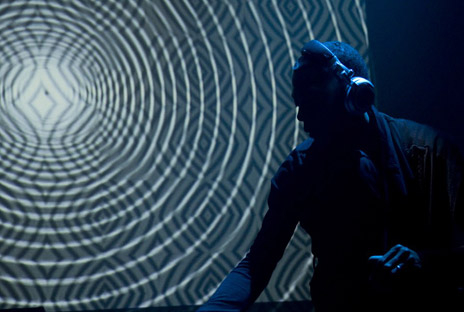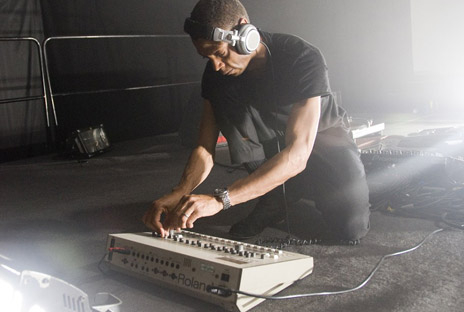- Lost have been doing their Spacebase parties in Plastic People regularly over the last few years, but the last full-scale Lost was some two years ago. It's fitting that they brought Jeff Mills in for the return; his long-running relationship with the promoters has seen him on the bill many times. Even with its billing as such, though, this night wasn't on the same scale as previous Lost parties. It was, assuredly, more than a Spacebase party. But even if you had the feeling that you were going to techno church, it was also somewhat more toned-down, and more refined.
Contributing to this effect was that the punter emerged from behind heavy drapes upon entry, or that there was a large ornamentally framed mirror hanging at one end of the smaller Spacebase zone by the bar. The club's brick railway arches were well populated, but not rammed. And I'm sure the main room was smaller than when the venue was SeOne, with a fairly expansive stage area taken up by Mills and his decks, CDJs, and 909 arranged in a semicircle.
 Photo credit: Sam Donnison and Takahiro Nakayama
The Sleeper Wakes, then:
"...is a project about Great Change... exploring time and the absence of it. It explores the various methods of creating sound for a specific time in Space for our future, the preparation and calculation of what could and will be and most importantly, what we do with this sensitive and rare opportunity".
Photo credit: Sam Donnison and Takahiro Nakayama
The Sleeper Wakes, then:
"...is a project about Great Change... exploring time and the absence of it. It explores the various methods of creating sound for a specific time in Space for our future, the preparation and calculation of what could and will be and most importantly, what we do with this sensitive and rare opportunity".
 Photo credit: Sam Donnison and Takahiro Nakayama
Some people get Mills' projects, and some don't; some of them, like Something in the Sky, have a more direct and clear message. Some of them, like the more esoteric likes of Sleeper, might communicate more intimately with the subconscious, but also not leave as much of an obvious imprint upon the cerebrum. As he played off the floor, with hypnotic concentric circles displayed behind him, he seemed to be bringing attention to particular features of the music—the sounds and the way they were structured together—with fairly immediate selections, tracks where their characteristics were accentuated, and contrast between adjacent ones. A highly aggressive pounder would segue into something more drifting. Maybe his aim was to bring to the fore deeply held beliefs about the composition and nature of techno, and, by extension, the universe, and explore the possibilities of subsequent advancement, through this approach.
Many artistic concepts defy explanation, but leave the observer with a strong feeling about... well... something. Features of Mills' previous sets like off-beatmatching, sharp volume changes and "The Bells" were there, so personally I was left unsure of how this particular concept was individual and what it really meant; my surmises above may be way off the mark. Perhaps repeat exposure would clarify. Perhaps just the overall feel of something new, of progression, was the intended effect. But whether you see him as a shaman, or whether you're nonplussed—perhaps we just don't expect this kind of thing yet—one thing's for certain: he is, as he's always been, a true vanguard.
Photo credit: Sam Donnison and Takahiro Nakayama
Some people get Mills' projects, and some don't; some of them, like Something in the Sky, have a more direct and clear message. Some of them, like the more esoteric likes of Sleeper, might communicate more intimately with the subconscious, but also not leave as much of an obvious imprint upon the cerebrum. As he played off the floor, with hypnotic concentric circles displayed behind him, he seemed to be bringing attention to particular features of the music—the sounds and the way they were structured together—with fairly immediate selections, tracks where their characteristics were accentuated, and contrast between adjacent ones. A highly aggressive pounder would segue into something more drifting. Maybe his aim was to bring to the fore deeply held beliefs about the composition and nature of techno, and, by extension, the universe, and explore the possibilities of subsequent advancement, through this approach.
Many artistic concepts defy explanation, but leave the observer with a strong feeling about... well... something. Features of Mills' previous sets like off-beatmatching, sharp volume changes and "The Bells" were there, so personally I was left unsure of how this particular concept was individual and what it really meant; my surmises above may be way off the mark. Perhaps repeat exposure would clarify. Perhaps just the overall feel of something new, of progression, was the intended effect. But whether you see him as a shaman, or whether you're nonplussed—perhaps we just don't expect this kind of thing yet—one thing's for certain: he is, as he's always been, a true vanguard.
 Photo credit: Sam Donnison and Takahiro Nakayama
The Sleeper Wakes, then:
"...is a project about Great Change... exploring time and the absence of it. It explores the various methods of creating sound for a specific time in Space for our future, the preparation and calculation of what could and will be and most importantly, what we do with this sensitive and rare opportunity".
Photo credit: Sam Donnison and Takahiro Nakayama
The Sleeper Wakes, then:
"...is a project about Great Change... exploring time and the absence of it. It explores the various methods of creating sound for a specific time in Space for our future, the preparation and calculation of what could and will be and most importantly, what we do with this sensitive and rare opportunity".
 Photo credit: Sam Donnison and Takahiro Nakayama
Some people get Mills' projects, and some don't; some of them, like Something in the Sky, have a more direct and clear message. Some of them, like the more esoteric likes of Sleeper, might communicate more intimately with the subconscious, but also not leave as much of an obvious imprint upon the cerebrum. As he played off the floor, with hypnotic concentric circles displayed behind him, he seemed to be bringing attention to particular features of the music—the sounds and the way they were structured together—with fairly immediate selections, tracks where their characteristics were accentuated, and contrast between adjacent ones. A highly aggressive pounder would segue into something more drifting. Maybe his aim was to bring to the fore deeply held beliefs about the composition and nature of techno, and, by extension, the universe, and explore the possibilities of subsequent advancement, through this approach.
Many artistic concepts defy explanation, but leave the observer with a strong feeling about... well... something. Features of Mills' previous sets like off-beatmatching, sharp volume changes and "The Bells" were there, so personally I was left unsure of how this particular concept was individual and what it really meant; my surmises above may be way off the mark. Perhaps repeat exposure would clarify. Perhaps just the overall feel of something new, of progression, was the intended effect. But whether you see him as a shaman, or whether you're nonplussed—perhaps we just don't expect this kind of thing yet—one thing's for certain: he is, as he's always been, a true vanguard.
Photo credit: Sam Donnison and Takahiro Nakayama
Some people get Mills' projects, and some don't; some of them, like Something in the Sky, have a more direct and clear message. Some of them, like the more esoteric likes of Sleeper, might communicate more intimately with the subconscious, but also not leave as much of an obvious imprint upon the cerebrum. As he played off the floor, with hypnotic concentric circles displayed behind him, he seemed to be bringing attention to particular features of the music—the sounds and the way they were structured together—with fairly immediate selections, tracks where their characteristics were accentuated, and contrast between adjacent ones. A highly aggressive pounder would segue into something more drifting. Maybe his aim was to bring to the fore deeply held beliefs about the composition and nature of techno, and, by extension, the universe, and explore the possibilities of subsequent advancement, through this approach.
Many artistic concepts defy explanation, but leave the observer with a strong feeling about... well... something. Features of Mills' previous sets like off-beatmatching, sharp volume changes and "The Bells" were there, so personally I was left unsure of how this particular concept was individual and what it really meant; my surmises above may be way off the mark. Perhaps repeat exposure would clarify. Perhaps just the overall feel of something new, of progression, was the intended effect. But whether you see him as a shaman, or whether you're nonplussed—perhaps we just don't expect this kind of thing yet—one thing's for certain: he is, as he's always been, a true vanguard.